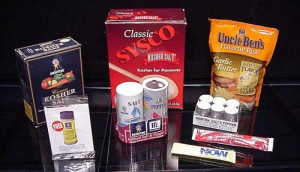 Food packaging serves many purposes, from protecting the food to creating portion sizes to offer information on the product.
Food packaging serves many purposes, from protecting the food to creating portion sizes to offer information on the product.
However, what is not well known about food packaging is the different types of packaging available. There are nine types, and are described below.
Aseptic Processing
This is for foods that are sterile and are to be maintained sterile. These items include liquid eggs, milk and milk product drinks, along with other foods that are processed and need to be preserved for longer periods of time. Aseptic packages are made of a mixture of paper, polyethylene, and aluminum and contain a tight inside layer of polyethylene. Sterile pharmaceuticals are mostly packaged in plastic or glass, such as syringes and vials.
Trays
This is mostly self-explanatory. Trays are what meats, plant seeds, and drinks can be carried in. They are mostly flat with raised edges to keep the product in place, and are made of various materials such as paperboard.
Bags
Like trays, bags are a common form of food packaging. Most commonly known are bagged snacks (chips, pretzels) and fruit (apples, potatoes). “Bagging” separates the food from the environment, namely the air.
Boxes
Boxes are used for the most easy form of transportation of a food product. Most common materials found in boxes are metal, corrugated fiberboard, and wood. Frozen pizzas, cereals, and snack crackers are examples of foods packaged in boxes.
Cans
Cans are also an excellent way of preserving and transporting foods. Most cans are made of steel or other thin metal when found in stores, as well as glass jars when foods are canned in the home.
Cartons
Boxes and cartons are oftentimes interchangeable. Like boxes, cartons are also made out of corrugated fiberboard and are used for transporting food. Within the food packaging type of cartons, there are four sub-categories. The most well-known is the egg carton which is molded to the shape of the egg to add protection while the food product is mobile. Aseptic cartons also lie in this category. Examples of this are milk, juice, and soup cartons. Another sub-category of cartons are the folding cartons, which begin as flat pieces of corrugated fiberboard and then assembled by the food manufacturer. Lastly, there are gable tops. These cartons usually hold milk or juice and require the gables at the top to be pinched then pulled in order to be opened.
Flexible packaging
Similar to bags, flexible packaging protects the food protect from the environment and create an adequate means of transporting foods. Bagged salad is a common food found in flexible packaging.
Pallets
Pallets are used for mass transportation of a product. Boxes of the product are placed and stacked on the pallet, then wrapped to secure and decrease food movement.
Wrappers
Used for individual items, wrappers provide protection between the food and the environment or the food and a person’s hands. Candy bars are most commonly thought of.

What a fantastic post!
This is so chock full of useful information i can`t wait to dig deep and start utilizing the resources you have given me. Your exuberance is refreshing.
That is a good post! I really appreciate your effort and grateful to read this an amazing Types. That amazing 2nd and 4th type.
Thank u so much for posting this useful information! 🙂
Well explained. You’ve covered all most everything about food packaging. The points you’ve mentioned above will be a great help if someone wants to enter into the food packaging industry.
complete detail about food packaging, thanks
It stood out to me when you explained that wrappers are used for packaging individual items. I would think that it would be a good idea to use a wrapper if you are placing bottles into some kind of crate. It seems like you would want to wrap the bottles before they are packaged so that they don’t break while being transported.
I would like to express my sincere gratitude for sharing this informative and well-written article. It is indeed essential for consumers to be well-versed in the various types of food packaging available in order to make informed choices. The explanations provided were clear, concise, and easy to follow, enabling me to gain a deeper understanding of the sustainability aspects of each type of packaging and their corresponding environmental impacts. I commend you for sharing such valuable information that empowers consumers to make conscious decisions for the betterment of our planet.
Great article! 👏 Very informative and well-structured breakdown of the different types of food packaging. It’s helpful to understand the unique features and purposes of each type—definitely a useful read for businesses in the food industry!